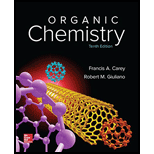
Concept explainers
Interpretation:
The compounds given in each group, that is, isomers, are to be identified, and whether they are constitutional isomers or stereoisomers, is to be specified.
Concept introduction:
Compounds that have the same molecular formula, but have different structures are classified as isomers.
The bond-line formulas must be expanded, and all atoms must be shown. This clearly shows all the atoms of similar element present in the structure. From this, the molecular formula can be written.
Stereoisomers are isomers have their atoms bonded in the same order, with similar in constitution, but different in the arrangement of atoms. If structures cannot be made identical by rotation around one or more single bonds, the structures are stereoisomers.
When cyclohexane ring flips, any substituent that is axial in the original chair conformation becomes equatorial in the ring-inverted form and vice versa.
Trending nowThis is a popular solution!

Chapter 3 Solutions
Solutions Manual for Organic Chemistry
- Classify each pair of compounds as either identical, constitutional isomers, stereoisomers, or not isomers.arrow_forwardCategorize each pair of structures using all the terms that apply: Identical, isomers, constitutional isomers, stereoisomers, enantiomers, and diastereomers.arrow_forwardAre compounds A and C isomers? Are compounds C and D isomers? Are compounds C and E isomers? (Applies to the 3 questions above)Are they constitutional isomers or stereoisomers?arrow_forward
- Which stereoisomer has the lower overall energy? Draw the chair for the lowest energy conformation.arrow_forwardLabel each pair of compounds with the appropriate label of their relationship: conformational isomers; stereoisomers, constitutional isomers, or two different compounds.arrow_forwardIllustrate a comparison of constitutional isomers and stereoisomers ?arrow_forward
- Classify each pair of compounds as constitutional isomers, stereoisomers, identical molecules, or not isomers of each attached otherarrow_forwardDetermine if each compound is a. constitutional isomers b. enantionmers c. diastereomers d. the same moleculearrow_forwardwhat is the relationship between these compounds, constitutional isomer, enantiomer, diastereomer, same compound?arrow_forward
- Indicate whether the pair of structures shown represent stereoisomers, constitutional isomers, different conformations of the same compound, or the same conformation of a compound viewed from a different perspective.arrow_forwardsort the compounds into pairs of constitutional isomers, stereoisomers, or identical moleculesarrow_forwardCan you show the isomers and alchols present with a molecular formula?arrow_forward
 Organic ChemistryChemistryISBN:9781305580350Author:William H. Brown, Brent L. Iverson, Eric Anslyn, Christopher S. FootePublisher:Cengage Learning
Organic ChemistryChemistryISBN:9781305580350Author:William H. Brown, Brent L. Iverson, Eric Anslyn, Christopher S. FootePublisher:Cengage Learning
